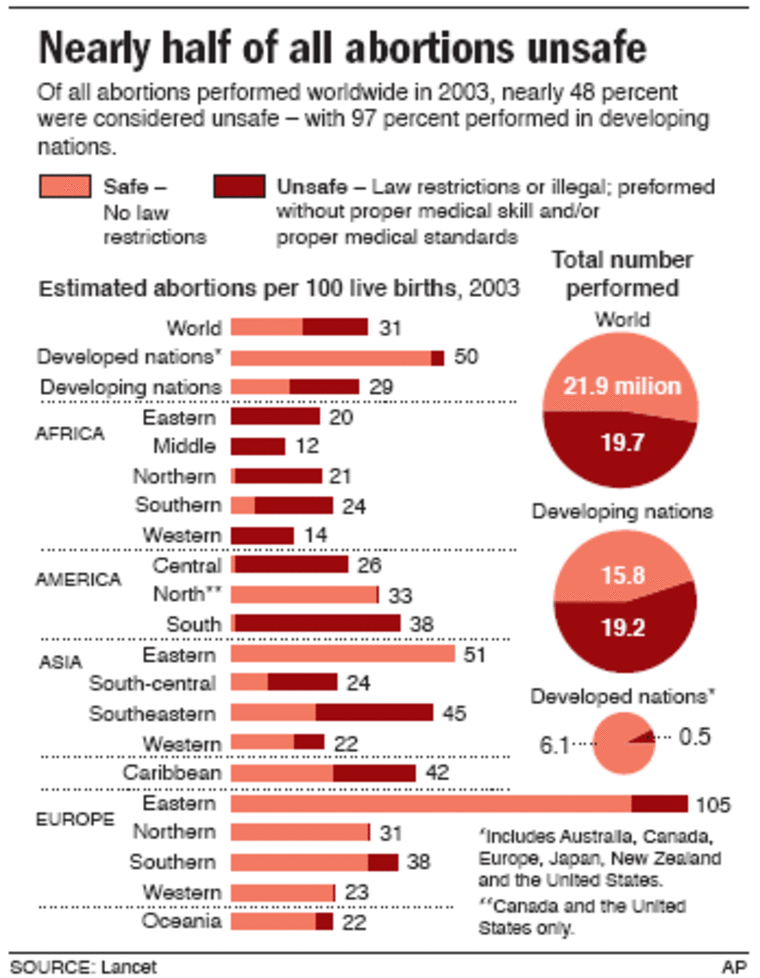Women are just as likely to get an abortion in countries where it is outlawed as they are in countries where it is legal, according to research published Friday.
In a study examining abortion trends from 1995 to 2003, experts also found that abortion rates are virtually equal in rich and poor countries, and that half of all abortions worldwide are unsafe.
The study was done by Gilda Sedgh of the Guttmacher Institute in the United States and colleagues from the World Health Organization. It was published in an edition of The Lancet medical journal devoted to maternal health.
“The legal status of abortion has never dissuaded women and couples, who, for whatever reason, seek to end pregnancy,” Beth Fredrick of the International Women’s Health Coalition in the U.S. said in an accompanying commentary.
Maternal mortality
Abortion accounts for 13 percent of maternal mortality worldwide. About 70,000 women die every year from unsafe abortions. An additional 5 million women suffer permanent or temporary injury.
“The continuing high incidence of unsafe abortion in developing countries represents a public health crisis and a human rights atrocity,” Fredrick wrote.
The number of worldwide abortions has dipped from about 46 million in 1995 to just under 42 million in 2003. But there was no change in the rate of unsafe abortions; nearly half the procedures are still performed illegally in potentially dangerous conditions.

“The only way to decrease unsafe abortion is to increase contraception,” said Sharon Camp, president and chief executive officer of the Guttmacher Institute.
Camp said that more countries are allowing women to have abortions legally, but many women only receive medical attention after a procedure has gone wrong. “I don’t think women should have to hurt themselves before they get medical treatment,” she said.
Unsafe abortions
The vast majority of abortions — 35 million — were in the developing world. And nearly 97 percent of all unsafe abortions were in poor countries. Worldwide, one in five pregnancies ends in abortion.
The study defined unsafe abortions as those performed either by people lacking the necessary skills or in an environment that does not conform to minimum medical standards.
In eastern Europe, there are more abortions than live births: 105 abortions for every 100 live births, the research found. In Western Europe, there are 23 abortions for every 100 live births.
In North America, there are 33 abortions for every 100 live births, while in Africa, where abortion is illegal in most countries, there are 17 abortions for every 100 live births.
Improving women’s health, experts said, means improving access to safe abortions. Some experts criticized the restrictions that often come with donor money. Funds from the U.S. government, for example, cannot be used in any health services associated with abortion.
Because providing safe abortions depends on a working health care system, experts said tackling the problem is difficult.
In related papers published in The Lancet this week, experts said there has been little improvement in helping women survive pregnancy and childbirth in the last two decades, particularly in the world’s poorest countries.
Unlike improving child health, which can be done relatively easily by things like immunizing children against various diseases, “you can’t give women a pill for obstetric complications,” said Ann Starrs, executive vice president for Family Care International in the U.S., who was not linked to the study.
Competing with other health issues for limited health dollars is also a problem.
“Donors love to distribute bed nets for malaria because it’s simple to do and it’s easy to show the progress you’ve made,” said Dr. Lale Say, a WHO maternal health expert. “But unfortunately for women’s health, there is no single strategy that will work everywhere.”